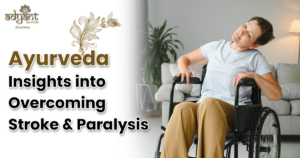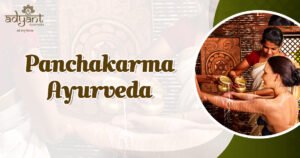Table of Contents
ToggleIntroduction: The Ancient Art of Healing and Detoxification
In today’s fast-paced world, where stress, pollution, and unhealthy lifestyle choices take a toll on our health, finding a natural and holistic way to rejuvenate the body and mind has become essential. Ayurveda, the 5,000-year-old system of natural healing, offers a profound solution: Panchakarma.
Panchakarma, meaning “five actions,” is a deeply transformative Ayurvedic detox therapy designed to restore the body’s natural balance by eliminating toxins and rejuvenating tissues. Rooted in ancient healing traditions, this powerful cleansing therapy not only detoxifies but also strengthens the immune system, balances the doshas (Vata, Pitta, and Kapha), and promotes overall well-being.
At Adyant Ayurveda, we bring the wisdom of classical Panchakarma treatments tailored to individual needs, ensuring a holistic healing experience that aligns with modern wellness goals.
Understanding Panchakarma: The Science Behind Holistic Healing
Ayurveda, often described as a science of life, is based on the balance of the five fundamental elements—Ether, Air, Fire, Water, and Earth—which constitute everything in the universe. These elements combine to form the three doshas:
Vata (Air & Ether): Governs movement, creativity, and nervous functions.
Pitta (Fire & Water): Controls metabolism, digestion, and energy production.
Kapha (Earth & Water): Provides structure, stability, and immunity.
When these doshas are imbalanced due to stress, poor diet, or environmental factors, diseases and disorders arise. Panchakarma aims to correct these imbalances through a series of purification processes, helping the body eliminate toxins (Ama) and rejuvenate from within.
The Five Core Treatments of Panchakarma
1. Vamana (Therapeutic Emesis) – Cleansing Excess Kapha
Vamana is a controlled vomiting therapy that eliminates excess Kapha dosha from the body. It is particularly beneficial for:
Respiratory disorders (asthma, bronchitis)
Skin diseases
Digestive issues caused by excessive mucus accumulation
2. Virechana (Purgation Therapy) – Balancing Pitta
Virechana uses herbal purgatives to remove excess Pitta dosha from the body, targeting:
Liver disorders
Skin conditions (eczema, psoriasis)
Digestive disturbances (acid reflux, gastritis)
3. Basti (Enema Therapy) – Healing Vata Imbalances
Basti is one of the most effective therapies in Ayurveda, involving the administration of medicated enemas to remove accumulated toxins and balance Vata dosha. It is used for:
Joint disorders (arthritis, gout)
Neurological issues
Chronic constipation
4. Nasya (Nasal Administration) – Detoxifying the Head & Neck
Nasya involves the application of herbal oils or powders through the nasal passages, beneficial for:
Sinusitis and nasal congestion
Migraines and headaches
Mental clarity and focus
5. Rakta Moksha (Bloodletting) – Purifying the Blood
Rakta Moksha is a specialized therapy that removes toxins from the bloodstream, aiding in:
Skin disorders (acne, pigmentation, eczema)
Chronic inflammatory conditions
Circulatory issues
The Panchakarma Experience: A Step-by-Step Process
1. Purvakarma – The Preparation Phase
Before beginning Panchakarma, the body is prepared using two key techniques:
Snehan (Oleation): Internal and external application of medicated oils or ghee to soften and mobilize toxins.
Swedana (Sweating Therapy): Induced sweating to help expel toxins from the body.
2. Pradhanakarma – The Main Detox Therapies
Once the body is primed, the appropriate Panchakarma therapies (Vamana, Virechana, Basti, Nasya, or Rakta Moksha) are administered based on individual needs and imbalances.
3. Paschatkarma – Post-Treatment Rejuvenation
After detoxification, a structured diet, lifestyle modifications, and Rasayana (rejuvenation therapy) are recommended to maintain balance and prevent relapse.
Top Benefits of Panchakarma
✅ Deep Detoxification
Removes accumulated toxins, cleansing the body at both physical and cellular levels.
✅ Boosted Immunity
Strengthens the body’s defense mechanisms, making it more resilient against infections and diseases.
✅ Enhanced Mental Clarity & Stress Reduction
Relieves mental fog, anxiety, and stress, promoting emotional well-being.
✅ Improved Digestion & Metabolism
Balances digestive fire (Agni), ensuring proper absorption of nutrients and elimination of waste.
✅ Anti-Aging & Rejuvenation
Promotes cellular regeneration, slows aging, and revitalizes the body.
Who Can Benefit from Panchakarma?
Panchakarma is suitable for individuals looking to detox, rejuvenate, or manage chronic health conditions, including:
Digestive Disorders: IBS, acidity, constipation
Skin Conditions: Psoriasis, eczema, acne
Respiratory Issues: Asthma, sinusitis
Joint & Neurological Disorders: Arthritis, migraines, sciatica
Stress & Anxiety: Insomnia, mental fatigue
Experience Authentic Panchakarma at Adyant Ayurveda
At Adyant Ayurveda, we specialize in authentic and personalized Panchakarma treatments conducted under expert supervision. Our team of highly experienced Ayurvedic doctors ensures that every treatment is customized to your body type and health condition.
🌿 Why Choose Adyant Ayurveda?
✔ 24+ Years of Expertise in Ayurveda & Panchakarma
✔ Highly Experienced Ayurvedic Doctors & Therapists
✔ Customized Detox Programs for Individual Needs
✔ State-of-the-Art Panchakarma Facilities
✔ 100% Natural & Herbal Therapies
Conclusion: Embrace Ayurveda for a Healthier You
Panchakarma is more than just a detox; it is a holistic journey towards complete well-being. Whether you seek physical healing, mental clarity, or spiritual rejuvenation, Ayurveda’s timeless wisdom offers a path to optimal health.
Discover the transformative power of Panchakarma at Adyant Ayurveda, and experience a renewed sense of vitality, balance, and harmony.
📞 Book Your Consultation Today! Call us at 9972541009 or visit our centers in Bangalore.
Frequently Asked Questions (FAQs)
🔹 What is Panchakarma, and how does it contribute to holistic well-being?
Panchakarma is a therapeutic detox process in Ayurveda designed to cleanse, rejuvenate, and balance the body’s natural energies.
🔹 How are the five elements and the tridosha theory integrated into Ayurvedic philosophy?
The five elements (Earth, Water, Fire, Air, Ether) combine to form the three doshas (Vata, Pitta, Kapha), which govern all bodily functions.
🔹 Who should not undergo Panchakarma?
Pregnant women, severely ill patients, and those with extreme weakness should consult an Ayurvedic doctor before undergoing Panchakarma.
Ready to begin your Panchakarma journey?
Visit Adyant Ayurveda and unlock the ancient secrets of health and longevity! 🌿






